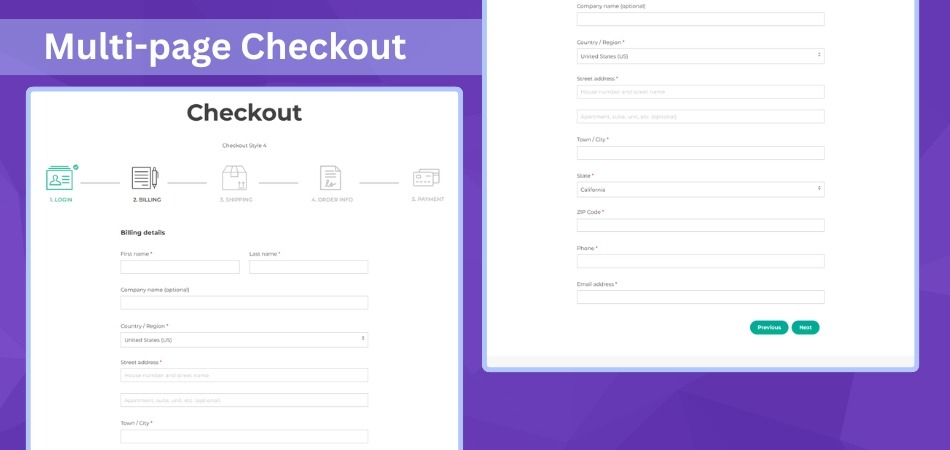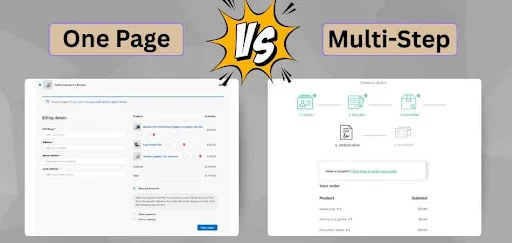Online shopping success depends a lot on how smooth the checkout process feels. A few seconds of delay can make a buyer leave the cart. That’s where the debate of One-page Vs Multi-page Checkout: Which is better for WooCommerce? becomes important. The right choice can help stores sell faster and keep customers happy.
In short, one-page checkout is fast, simple, and ideal for quick sales. Multi-page checkout gives more structure and works better for detailed orders. Both styles help stores in different ways depending on their products and customers. Knowing the difference can help you pick the one that fits your WooCommerce store best.
Before making your decision, think about what your buyers really want. Some prefer speed, others want clarity and control while ordering. Both options can work well when designed right for your audience. Continue reading to learn which checkout style can bring better results for your online store.
What is One-page Checkout?
A one-page checkout is a simple online shopping process where everything happens on a single page instead of several steps. It combines all checkout actions like filling in shipping details, selecting payment methods, and confirming the order on one screen. This setup saves time and reduces confusion, helping customers finish their purchase faster without clicking through many pages.
The process starts when a customer adds a product to the cart and clicks on checkout, taking them directly to one clean page. On that page, they can enter shipping information, choose delivery options, and fill in payment details easily. Everything is visible together, so buyers can check and fix any mistakes instantly before placing the order.
Once all information is filled out, customers can review their order summary and confirm the purchase without switching pages. This simple method makes online shopping smoother and reduces the chance of cart abandonment. Many stores use this system because it improves user comfort and helps increase successful sales quickly.
Key Advantages of Using One-Page Checkout
Online shopping feels best when the checkout is quick and easy for everyone. A long, slow checkout often makes customers leave early. That is why one-page checkout has become a smart and simple choice. Let’s look at the main advantages that make it helpful and worth using.
Faster Checkout Process
A one-page checkout saves time by keeping all steps on one screen. Buyers don’t have to move through many pages to finish. With One Page Checkout for WooCommerce, customers can complete their orders faster in just a few clicks. The faster process helps customers complete purchases without getting bored or distracted easily.
Fewer Clicks and Steps
This method cuts out extra steps that often make shopping slow and tiring. Customers can fill in details, choose payment, and confirm without changing pages. Fewer clicks mean a smooth and easy experience for everyone. It feels simple, and users can finish shopping faster without losing focus or interest midway.
Lower Cart Abandonment Rate
Many people leave their carts because checkout feels too long. A single-page design removes that problem by making everything quick and clear. Customers see all details at once and complete their orders faster. This helps online stores reduce cart drop rates and increase successful sales with less effort.
Better User Experience for Mobile Shoppers
Mobile users enjoy one-page checkout because it’s simple and scroll-friendly. They don’t need to switch screens or reload pages repeatedly. Everything fits nicely on one page, making it easier to complete purchases. This setup keeps mobile buyers happy and encourages them to shop more often online.
Easy to Review and Edit Details
Shoppers can check their information easily before confirming their order. If they notice a mistake, it’s simple to fix it instantly. They don’t have to go back through several steps to correct details. This quick editing option makes checkout stress-free and helps avoid wrong or incomplete orders.
Increases Customer Satisfaction
When checkout is fast and simple, buyers feel more relaxed and confident. They trust the process and enjoy shopping more often. A clear, single-page setup gives them better control over their orders. Satisfied buyers often return and recommend the store to others they know.
Who Should Use One-page Checkout?
Many online stores want faster and easier checkout for their buyers. Not every business needs a big checkout system with many steps. One-page checkout fits best for certain kinds of online shops. Here are some businesses that will benefit the most from this simple checkout style.
Small and Medium Online Stores
These stores often have limited products and smaller order sizes. They benefit the most from a one-page checkout because it saves time. Owners can give customers a quick and clear shopping experience without a heavy setup. This makes the process simple for buyers and helps the store complete more sales easily.
Stores With Repeat Customers
When people buy often, they want the checkout to be fast and easy. Returning customers already know what they want, so fewer steps help them finish faster. They can quickly confirm details and pay without waiting too long. This comfort keeps them coming back for future purchases happily.
Businesses Selling Few Items Per Order
Some shops sell only one or two products at a time. A long, multi-step checkout doesn’t make sense for such small orders. One-page checkout lets customers fill in details and pay in seconds. This quick process fits perfectly for businesses that sell small or single-item purchases regularly.
Digital Product Sellers
Online sellers who sell digital goods like ebooks or music can use this setup easily. It avoids the need for shipping steps and makes payment quick. Buyers can download their items right after purchase without delay. This smooth process helps keep customers satisfied and ready to buy again soon.
Subscription-based Stores
Shops that offer monthly or yearly subscriptions benefit from a simple checkout. Buyers can choose their plan, fill in details, and pay on one page. It reduces confusion and makes sign-ups faster for new users. The cleaner setup helps keep people subscribed longer with fewer dropouts or missed sign-ups.
Niche or Specialty Shops
Small niche stores often focus on a limited set of items. A one-page checkout keeps the process clean and easy for their customers. It helps shoppers complete orders without wasting time or switching screens. This setup also gives a more personal and smooth shopping experience for loyal buyers.
What is Multi-page Checkout?
A multi-page checkout is a step-by-step process that divides the checkout into several pages for better order organization. Each page focuses on a specific task, like adding shipping details, selecting payment options, or confirming the order. This method helps buyers move through each part carefully before finishing their purchase to avoid mistakes or confusion.
When customers add items to their cart and go to checkout, they see a series of separate pages to complete. The first page usually asks for contact and shipping information, followed by payment details on the next page. Finally, they reach a confirmation page where they can review everything before submitting the order safely.
This process is slower than one-page checkout, but it can feel more structured and easier to follow for new shoppers. It allows customers to double-check their information at every stage before paying. Many big online stores use multi-page checkout because it handles complex orders smoothly and gives users time to review each step.
Key Advantages of Using Multi-page Checkout
Many online stores use multi-page checkout to make each step clear and simple. It divides the process into smaller, focused pages. This helps customers handle one thing at a time without feeling rushed. Let’s look at the main advantages that make this checkout method useful for online stores.
Easier to Collect Detailed Customer Data
Multi-page checkout allows stores to collect customer information in small, clear sections. Each page focuses on one task, like shipping or payment. This setup helps gather complete and accurate data without overwhelming the buyer. It also gives businesses better insights into their customers’ shopping habits for future sales and support.
Feels More Organized for Some Users
Some shoppers prefer a slow and steady process when checking out. This system guides them step-by-step, so nothing feels confusing or crowded. Each page has a clear purpose, which helps reduce mistakes. It gives buyers more comfort and confidence while completing their purchase on different checkout screens.
Better for Large or High-Value Orders
Big orders often need extra time and careful checking before payment. A multi-page setup gives users space to review all details calmly. They can confirm prices, shipping options, and payment safely without pressure. This structure makes it ideal for high-value or complex product purchases that need careful attention.
Easier to Add Upsells or Account Creation Steps
Stores can use extra pages to offer related products before final checkout. It’s also easier to include account creation or newsletter sign-up options. This method helps businesses build customer relationships and increase sales smoothly. The flow feels natural and not forced, keeping buyers interested till the end.
Suitable for Complex Product Options
When products need special details, like custom designs or gift wrapping, this layout works well. It lets shoppers enter information step-by-step without missing anything. Each stage can collect unique order choices neatly and clearly. This helps ensure buyers get exactly what they ordered without confusion or errors.
Ideal for New Online Shoppers
New buyers may find too many options on one page confusing. Multi-page checkout breaks things down, making it easier to understand. Each section explains what to do next in a simple way. This setup helps new customers feel confident and finish their orders successfully.
Who Should Use Multi-page Checkout?
Not every business needs a one-page checkout for their store. Some companies sell complex items that need more detailed steps. Multi-page checkout helps them manage these details without confusing buyers. Here are the types of businesses that can benefit most from this checkout method.

Large Ecommerce Stores
Big online stores handle hundreds of orders every single day. A multi-page checkout helps them manage complex steps like shipping, billing, and order review easily. Each section is clear, helping customers move through the process smoothly. This layout also helps businesses handle higher traffic and detailed order processing without errors.
Businesses With Complex Products
Companies selling custom or detailed products often need extra order steps. They must collect product details, design notes, or special shipping needs carefully. A step-by-step checkout makes it easier to manage that data correctly. This way, customers feel sure that their special requests are recorded and processed properly every time.
Brands Needing Customer Verification Or Account Creation
Some brands want buyers to create accounts or verify their details before purchase. This helps with record-keeping, loyalty points, and safe transactions. Multi-page checkout gives space for these extra steps without confusing buyers. It also ensures the process stays secure and smooth for both the business and the customer.
Subscription-based Companies
Businesses that offer subscription boxes or repeated services benefit from multi-page checkout. It helps them confirm payment details, billing cycles, and shipping addresses accurately. These steps are important for recurring orders that must renew automatically. A clear and steady process helps reduce mistakes and improve customer trust easily.
Luxury or High-End Brands
High-value products often need more careful review before checkout. A detailed multi-step process helps buyers feel secure while paying large amounts. Each stage confirms the details clearly, which builds confidence. This checkout flow fits perfectly for luxury brands that care about a professional and trusted buying experience.
Companies Collecting Extra Customer Information
Some stores collect more data for shipping, feedback, or marketing. A single-page setup may not have enough space for that. Multi-page checkout lets them gather customer preferences in smaller parts easily. It keeps the process neat while giving businesses useful information to improve their services later.
One-page Vs Multi-page Checkout: Which Is Better for WooCommerce?
Here is a quick comparison of the two. The key differences are summarized in this table.
| Feature | One-page Checkout | Multi-page Checkout |
| Speed | Faster and saves time since all steps are on one page. | Slower as users go through several pages to finish checkout. |
| User Experience | All information appears together, making it quick but sometimes crowded. | Offers a step-by-step guide with simple and focused forms. |
| Mobile Experience | Works well on mobile if forms are collapsible or short. | Can feel clumsy on small screens if not designed properly. |
| Analytics Tracking | Hard to track where users leave the process mid-way. | Easier to track which step users drop off from checkout. |
| Upsell Opportunities | Fewer chances to display extra offers or add-ons. | Easier to include upsells between steps or before confirmation. |
| Best For | Great for quick buys, simple items, and digital products. | Better for expensive, customized, or complex product orders. |
| Customer Focus | Perfect for repeat buyers who value speed and ease. | Ideal for new customers who need more guidance and clarity. |
| Order Accuracy | Fast checkout might cause small mistakes if details are missed. | Step-by-step process reduces errors and ensures accurate details. |
Speed
One-page checkout moves faster because everything is on one screen. Customers can fill in details, review, and pay instantly. Multi-page checkout takes a bit longer since buyers move through several steps. The extra time can help avoid mistakes, but it may feel slow for quick shoppers.
User Experience
One-page checkout gives a quick view of all details in one place. It feels simple for returning buyers who already know what to do. Multi-page checkout guides users step-by-step, which feels more organized for new shoppers. Each page focuses on one action, keeping things clear and easy to follow.
Mobile Experience
On mobile, one-page checkout works well if forms are short or collapsible. It allows customers to scroll smoothly and finish quickly. Multi-page checkout can feel bulky if not well-designed for smaller screens. However, a clean layout can still make it user-friendly even on phones.
Analytics Tracking
Tracking buyer behavior is harder with one-page checkout because all actions happen together. It’s tough to see where users stop or leave. Multi-page checkout makes tracking easier since each step can be monitored. This helps store owners find problem points and improve the checkout experience.
Upsell Opportunities
One-page checkout focuses on speed, so upselling options are limited. There’s less space to suggest add-ons or special offers. Multi-page checkout allows more room for promotions between steps. Stores can show related products or upgrades before the final payment page.
Best For
One-page checkout suits small stores selling simple or digital products. It’s perfect for quick purchases that don’t need extra details. Multi-page checkout works better for high-priced or complex items. It lets customers review information slowly and confirm every detail carefully.
Customer Focus
One-page checkout is ideal for regular customers who value speed. They can finish shopping quickly without extra steps. Multi-page checkout helps new buyers who want guidance during checkout. It offers a calmer process, explaining each step clearly before the order is done.
Order Accuracy
Fast checkout can sometimes lead to skipped details or small errors. When all information appears together, it’s easy to miss something. Multi-page checkout reduces this problem by dividing steps neatly. Each page gives time to review, leading to more accurate orders and fewer issues.
Which Is Better for WooCommerce
Selecting between one-page and multi-page checkout depends on the type of store and the customer’s needs. Each one works better in different situations. The best option is the one that gives your buyers a smooth and stress-free checkout. Here’s a simple way to decide what fits your WooCommerce store best:
Pick One-page Checkout if:
- You sell simple or low-cost products that don’t need extra details.
- Most of your buyers are repeat customers who value quick shopping.
- You want faster checkout and fewer abandoned carts.
Choose Multi-page Checkout if:
- Your store sells expensive, detailed, or custom-made products.
- You need to collect customer data, verify accounts, or add upsells.
- You prefer clear tracking and organized steps during checkout.
Both checkout styles have strong points. One-page checkout focuses on speed and convenience, while multi-page checkout offers clarity and structure. The right choice depends on what helps your buyers finish their purchase comfortably and confidently.
Bottom Lines
Choosing between one-page and multi-page checkout isn’t about which looks better but which works best for your store. Every business has unique needs, and understanding how each option supports your buyers makes a big difference. The goal is to make checkout fast, clear, and stress-free for your customers.
In the debate of One-page Vs Multi-page Checkout: Which Is Better for WooCommerce, both have their strengths. One-page checkout offers speed and simplicity, while multi-page checkout provides structure and better tracking. What matters most is picking the one that gives your shoppers the easiest buying experience possible.
Before deciding, think about your products, customer type, and sales style. If your buyers value speed, go for one-page checkout. But if your store handles complex orders or needs extra details, multi-page checkout is the safer choice. The right setup can turn every visit into a completed sale.






